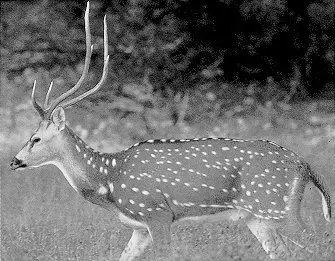|
Exotics: Axis (Chital) Deer Cartridges By Chuck Hawks  Axis deer are native to India and Ceylon, where they are known as chital, although they have been imported to other places all around the world. In addition to Asia, they are now found in Europe, Australia, New Zealand, North America, South America, and the Hawaiian Islands. In the U.S., the states of Texas, Hawaii and Florida probably have the largest axis deer populations. They were introduced in Texas during the 1930's and have prospered. Today there are tens of thousands of free roaming axis deer in Texas, and tens of thousands more on private hunting preserves. Axis are generally regarded as being the most beautiful of all deer species. Unlike North American deer that are only spotted as fawns, axis never lose their spots. Both male and female have striking reddish-brown coats marked by white spots arranged in undisciplined rows along their sides. They have a black dorsal stripe and a white patch under their chin and neck with white inner legs, underbody and beneath their tail. Bucks grow and shed their antlers annually. Mature axis bucks have only three points per side, growing off the sweeping main beam, but the main beams of their antlers are exceptionally long. 30" would be considered a trophy animal and I have seen bucks with longer main beams on the hoof. They are truly spectacular. In their native India, mature bucks typically average around 110 pounds in live weight, but in New Zealand and Texas, where there is a plentitude of nutritious fodder, they probably run between 145 and 250 pounds. The axis bucks I saw on the Double C ranch in South Texas were approximately twice the size of most of the native whitetails. These bucks appeared to me to be about the size of a mature Mule deer buck (200 pounds). Besides being beautiful, axis deer are wary creatures. They are among the most difficult of exotic trophies to collect. On the other hand, much exotic hunting is done from stands that offer a good rest and ranges seldom exceed 200 yards. In South Texas, where I have hunted, 100 yards (or 100 meters) is probably a typical kill distance. Any good North American deer cartridge is a good axis cartridge. Since ranges are typically not long, many of the classic woods cartridges are entirely appropriate. Figure on using a bullet carrying 800 ft. lbs. of energy at impact, as you would for hunting North American deer. One of the real problems with recommending hunting cartridges is that the vitality and state of mind of the individual animal has a lot to do with how hard it is to bring down. Most hunters have noticed how relatively easy it is to kill a relaxed animal that is just standing around, and how difficult it can be to stop an animal fleeing for its life. Even given good bullet placement, these are variables that are hard to account for in any list. The best way to insure a quick, humane kill on axis deer is accurate bullet placement with an adequate caliber bullet of proper design for the purpose. Magnum rifle cartridges are not required. Standard soft point or plastic tipped bullets such as the Nosler Ballistic Tip, Hornady InterLock, Remington Core-Lokt, Winchester Power Point and Sierra Pro Hunter will usually kill faster than slower expanding premium bullets. It would be too cumbersome to list every possible axis deer cartridge, and I would inadvertently leave out someone's favorite in any case. So the cartridges mentioned below are just examples of typical axis cartridges. If a cartridge is not listed it does not mean that it is inappropriate. Look for a cartridge with similar ballistics. If you find one, then the cartridge in question is also probably satisfactory. Examples of cartridges suitable for harvesting exotic axis deer in North America (and also in New Zealand and other places where they grow to similar size) include: .243 Winchester, 6mm Remginton, 6x62 Freres, .240 Weatherby, .25-35, .250 Savage, .257 Roberts, .25-06, 6.5x54 M-S, .260 Remington, 6.5x55 SE, 6.8mm SPC, .270 Winchester, 7mm-08, 7x57, 7x64 Brenneke, .280 Remington, .30-30, .300 Savage, .308 Marlin, .308 Winchester, .303 British, .32 Winchester Special, .35 Remington, .44-40 and .44 Rem. Mag. As you can see, this is a wide range of diverse cartridges. It is important to bear in mind that these are adequate calibers when used within their maximum point blank range (MPBR). The .44 Magnum and .44-40, for example, are short range cartridges that shed their energy and killing power fast. The .30-30 and .32 Special are medium range cartridges, adequate to around 200 yards. The .25-06 and .270 are long range cartridges that can reach out 300 yards. All are fine with proper bullet placement and when used within their MPBR (+/-3"). Please remember that when recommending deer cartridges I am assuming that the hunter uses a bullet of adequate weight, sectional density, expansion characteristics and gets it into a vital spot (usually the heart/lung area of the deer). It doesn't have to be a perfect shot that slips between two ribs and blows up the heart, but I am assuming a good shot with an adequate bullet. Bullet placement is, by far, the most important factor in killing power. Good luck and good hunting! |